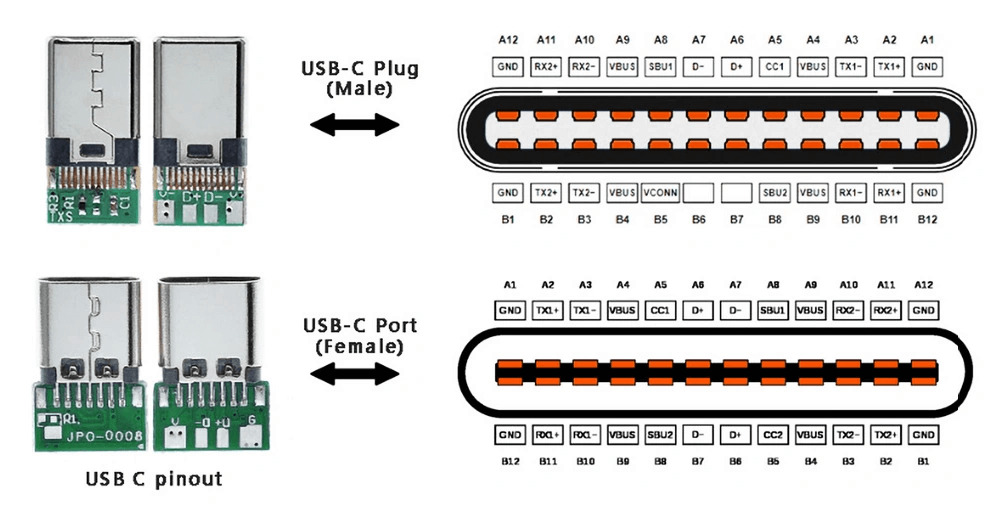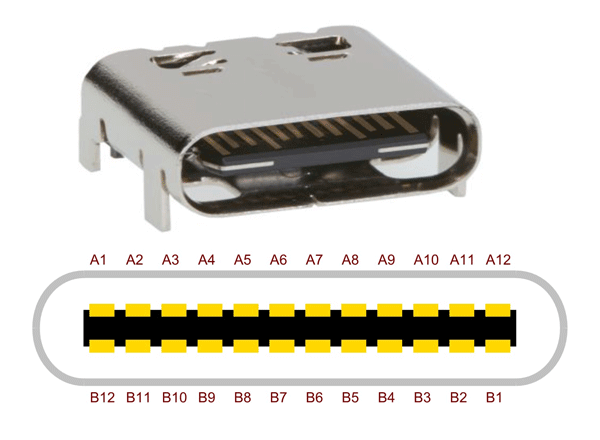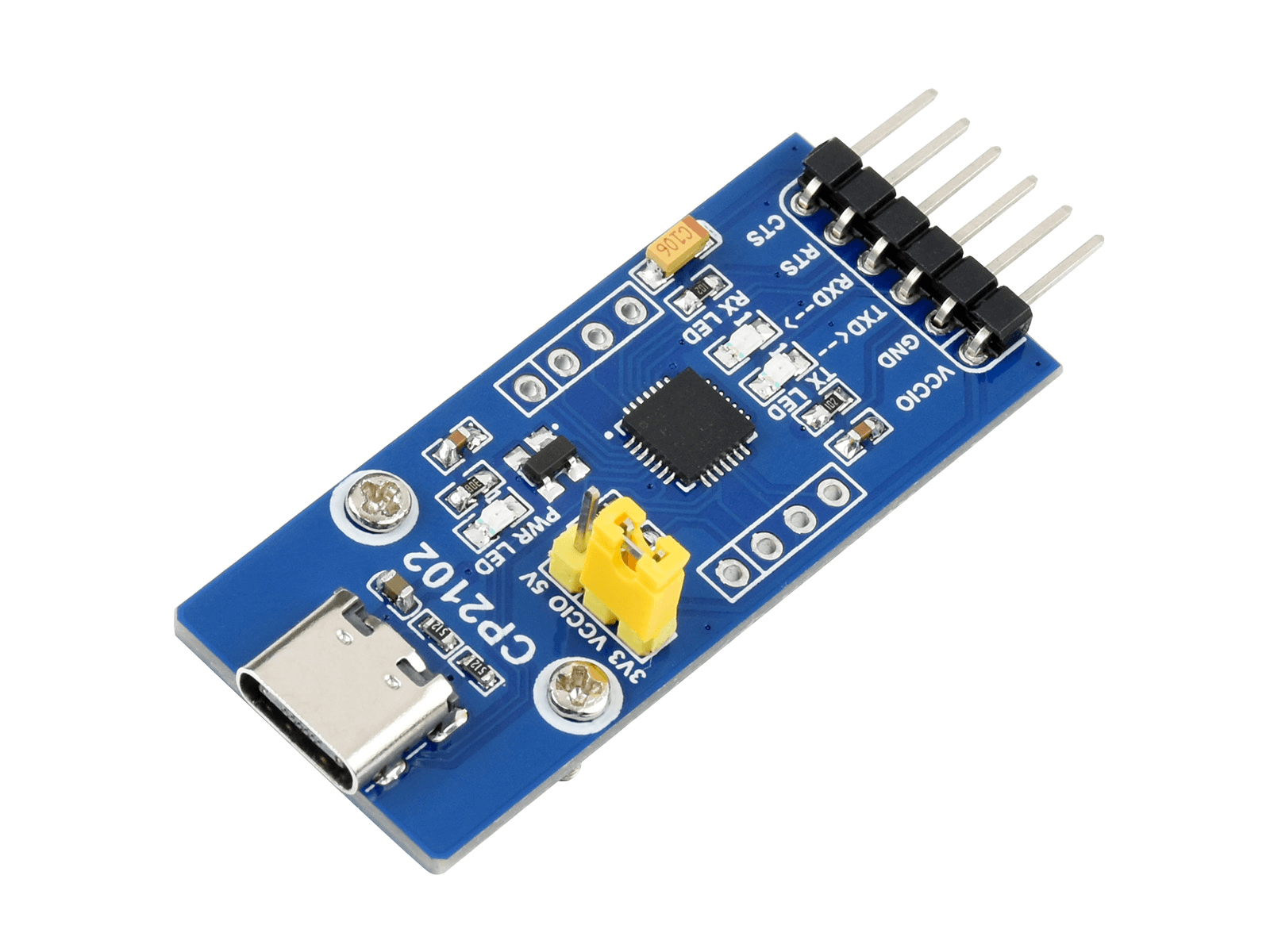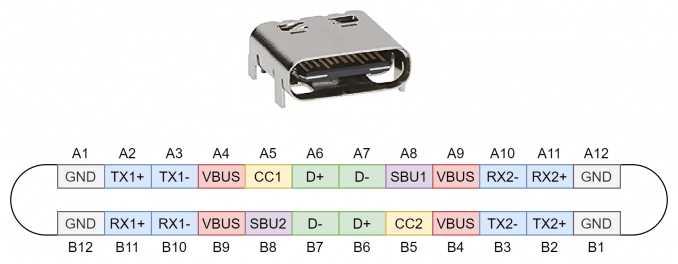USB-C Pinout and Features
USB-C, or USB Type-C, is a major advancement in connectivity standards, offering high-speed data transfer and efficient power delivery. With data transfer rates reaching up to 10Gb/s and power capabilities of up to 100W, USB-C has quickly become the universal standard for modern electronic devices. This standardization simplifies connections and greatly improves performance across a wide range of devices, including laptops, smartphones, and peripherals. The USB-C interface has many features: a user-friendly reversible connector, support for multiple data transfer standards, and advanced power delivery negotiation. Each of these features contributes to the versatility and efficiency of USB-C, making it a key element in contemporary technology. This guide explores the specifics of USB-C's pinout and features, explaining the technical details and functionality that support its widespread use and utility.Catalog

Figure 1: USB-C
What Is USB-C?
USB-C, or USB Type-C, is a modern connectivity standard that enables high-speed data transfer and efficient power delivery. It supports data transfer rates of up to 10Gb/s and can handle power flows of up to 100W. This versatility makes USB-C a universal standard for contemporary devices, ensuring fast data exchange and powerful charging capabilities. USB-C has become widely adopted in various devices, including laptops, smartphones, and peripherals, because it simplifies connections and boosts performance.
USB-C Features
Flippable Connector
The USB-C connector features a symmetrical, flippable design, making it very user-friendly. Unlike older USB connectors, which require a specific orientation, the USB-C plug can be inserted into the port in either direction. This change makes the connection process quicker and more convenient for users. Also, the reduced need for multiple attempts to correctly align the plug decreases wear and tear on both the connector and the port, which helps extend their lifespan.
Support for Multiple Standards
The USB-C interface supports various USB standards and third-party protocols, making it a comprehensive solution for diverse data transfer and video output needs. USB-C supports USB 2.0 with data transfer rates up to 480 Mbps for standard file transfers and peripheral connections. It also accommodates USB 3.0, offering speeds up to 5 Gbps for faster data handling. USB 3.1 Gen 2 enhances this further, delivering speeds up to 10 Gbps, ideal for high-resolution video editing and large file transfers.
USB-C's versatility extends with its support for Alternate Mode, allowing it to handle non-USB data protocols. DisplayPort Alternate Mode enables video and audio signal transmission, facilitating connections to monitors and TVs without separate cables, streamlining setups with fewer wires. HDMI support through USB-C allows connections to HDMI-equipped devices like older monitors and TVs, ensuring compatibility across different display technologies.
Thunderbolt 3 integration with USB-C combines multiple data and display protocols, including PCIe and DisplayPort, over a single cable. This supports high-speed data transfer up to 40 Gbps and connections to various devices, from high-performance external drives to 4K displays, ensuring top performance without needing separate connectors. USB-C also supports Mobile High-Definition Link (MHL), allowing portable devices to connect to larger displays like TVs and projectors using existing connectors. This is useful for mobile devices, enabling larger screens for presentations or media playback without extra adapters or cables.
Power Delivery Negotiation
USB-C stands out for its ability to deliver a lot of power to devices, managed through the USB Power Delivery (PD) protocol. USB-C can supply up to 20 volts and 5 amps, resulting in a maximum power output of 100 watts. This makes it suitable for charging larger devices like laptops and tablets, as well as smaller devices such as smartphones. Unlike older standards with fixed power outputs, USB-C allows for dynamic power negotiation, where devices communicate to select the right power level. This ensures the connected device receives the precise amount of power it needs, improving charging efficiency and preventing overloading.
USB Power Delivery supports various voltage and current levels, allowing devices to draw the most efficient power according to their needs. For example, a smartphone might need 5V at 2A, while a laptop might require 20V at 5A. This flexibility makes USB-C adaptable and optimizes energy use, reducing waste and heat generation.
The USB Type-C Receptacle/Plug Pins

Figure 2: USB-C Plug Pins
The USB Type-C connector has 24 pins that give it many uses. Eight pins handle SuperSpeed data transfer, supporting rates up to 10 Gbps for fast file exchange. Four pins are for power delivery, supporting up to 100 watts, allowing USB-C to charge laptops, power external devices, and transfer power between devices. The remaining pins manage ground connections, configuration, and communication protocols, making sure the connector works correctly and is flexible in its uses.
USB 2.0 Differential Pairs
The D+ and D- pins play a key role in USB 2.0 connectivity, allowing data transfer between devices. In the USB Type-C connector, these pins are duplicated, with two D+ pins and two D- pins in the receptacle. This design ensures that data transmission remains consistent regardless of the plug's orientation, keeping the connector's reversible nature. Even though there are two sets of these pins, they work as a single pair for USB 2.0 data transmission, providing reliable and efficient communication between connected devices. This redundancy not only makes it easier for users but also ensures strong data integrity during transfers.
USB-C Plug Pinout
The USB-C plug serves as the standard interface for many electronic devices, offering a unified and flexible connection. The Vbus (Voltage Bus) pins, A1 and B1, are key for power delivery. Initially set at 5V, the voltage can increase up to 20V or even 48V through Power Delivery (PD) negotiation, with a maximum current of 5A. This allows the USB-C to supply up to 240W of power, enough to charge larger devices like laptops. The dynamic adjustment ensures connected devices receive the right power based on their needs.
The D+ and D- pins, A6, A7, B6, and B7, are needed for high-speed data transfer, supporting USB standards such as USB 2.0, USB 3.0, and USB 3.1 Gen 2. These pins enable effective communication across devices operating under different USB standards, ensuring high-speed data transfer and backward compatibility with older USB versions.
The Configuration Channel (CC) pins, A5 and B5, are key for device communication. They manage power requirements, determine device roles (power source or power sink), and configure connection details. This negotiation helps optimize power delivery and data transmission.
The Sideband Use (SBU) pins, A2 and B2, handle sideband signals used in Alternate Mode signaling, allowing the USB-C to support non-USB functions like DisplayPort or HDMI. This expands the connector's functionality beyond standard USB capabilities, reducing the need for extra connectors.
The Identity (ID) pins, A4 and B4, detect the cable plug's orientation and identify accessories. They help determine whether a device should act as a power source or sink, ensuring correct power and data roles for connected devices. This improves user experience by ensuring proper connection and operation regardless of plug orientation.
The Ground (GND) pins, A3 and B3, provide the needed ground reference for power and data lines, ensuring the stable and safe operation of the USB-C connector. Proper grounding prevents electrical faults and maintains data transmission and power delivery integrity.
Power and Ground Pins

Figure 3: Power and Ground Pins
The VBUS and GND pins are key parts of the USB Type-C connector's power delivery system. The VBUS pin supplies power, while the GND pin provides the return path for electrical signals. By default, VBUS delivers 5V, but through negotiation between connected devices, this voltage can increase up to 20V, with a current capacity of up to 5A. This allows for a power delivery of up to 100W, suitable for charging larger devices like notebook computers. The ability to adjust power delivery dynamically is a key feature of USB Type-C, catering to various power needs.
The RX and TX Pins

Figure 4: Type-C UART Board
The RX (receive) and TX (transmit) pins are key for data transfer in USB 3.0 and USB 3.1 protocols. The USB Type-C connector has two sets of RX and TX differential pairs, which handle high-speed data transfer effectively. The flippable design of USB Type-C needs a multiplexer to ensure proper data line routing no matter how the plug is inserted, supporting the connector's reversible nature. These differential pairs also allow for Alternate Mode, enabling the USB-C connector to work with other protocols like DisplayPort or HDMI for video and audio transmission. They also support USB Power Delivery (USB PD), which lets devices negotiate power needs and deliver up to 100 watts for charging and powering larger devices.
The CC1 and CC2 Pins

Figure 5: Function Model for CC1 and CC2
The Channel Configuration (CC) pins, CC1 and CC2, are key parts of the USB Type-C standard. They detect the presence and orientation of the cable, ensuring correct alignment no matter how the connector is inserted. This feature allows for reversible plug orientation, making it easier for the user. Besides detecting orientation, the CC pins also inform connected devices about the power capabilities available through the connection, enabling efficient power management. Devices use this information to adjust their power consumption based on the maximum current the USB port can supply.
The CC pins also play an important role in the USB Power Delivery (PD) protocol and Alternate Mode functionality. By monitoring voltage levels on these pins, devices negotiate the appropriate power levels needed for optimal operation. This negotiation supports higher power delivery, faster charging, and the ability to power more demanding devices. The CC pins also help establish data communication protocols. When entering Alternate Mode, these pins configure the connection to support different data types, like video or high-speed data transfer, by reconfiguring the USB Type-C interface.
The VCONN Pin
The VCONN pin provides power to electronically marked and active cables equipped with re-driver chips or other electronic components. These active components improve signal quality and ensure reliable data transmission over longer distances or through complex routing paths. The VCONN pin delivers a 5V, 1W power source to these components, enabling their operation. This power supply is needed for cables that support high-speed data transfer and other advanced functions. By supplying the needed power to these components, the VCONN pin ensures that signal integrity is maintained, reducing the risk of data loss or corruption.
The SBU1 and SBU2 Pins

Figure 6: USB Type-C Receptacle (Front View)
The SBU (Sideband Use) pins, SBU1 and SBU2, are designed for low-speed signal paths and play a key role in the USB Type-C connector's versatility. These pins are primarily used in Alternate Mode, allowing the USB Type-C connector to support non-USB protocols like DisplayPort or HDMI. By using these sideband channels, the USB-C connector can carry different types of data, extending its functionality beyond standard USB operations. This multi-protocol support enables devices to use a single USB-C connector for multiple connection types, simplifying the design and reducing the number of required ports.
USB Power Delivery

Figure 7: USB Power Delivery
SB Power Delivery (PD) is an advanced system that greatly improves the use of USB Type-C connectors. It allows devices to negotiate and select the right power levels through single-wire communication over the CC (Configuration Channel) line. This process lets devices adjust power levels to match their specific needs, making USB-C more flexible and efficient. USB PD works by setting up a communication link between the power source and the device. This link is used to share information about power needs and capabilities. Once connected, the devices use the CC line to start the negotiation process, sharing their power profiles, which include details about the voltage and current levels they can support.
The system supports a wide range of power levels, from low power for small gadgets to high power for charging laptops and other power-hungry devices. This flexibility is achieved through predefined power profiles that set standard power levels. For example, USB PD can deliver power at different voltages, such as 5V, 9V, 15V, and 20V, with current levels ranging from 0.5A to 5A. This means a single USB-C port can effectively charge a smartphone, power a laptop, or even drive external displays. The ability to adjust power levels on the fly is particularly helpful for battery-powered devices. It ensures the device gets just the right amount of power, preventing overcharging and reducing heat buildup, which can extend battery life and improve safety. Also, the ability to deliver higher power levels allows for faster charging times, making it more convenient for users.
Besides power delivery, the system supports data transfer, allowing for power and data exchange over the same connection. This makes USB PD perfect for modern devices that need both power and high-speed data connectivity, such as smartphones, tablets, and laptops.
Alternate Modes

Figure 8: USB Type-C Alternate Modes
USB Type-C's support for Alternate Modes is one of its most compelling features, transforming it into a universal connector that can replace multiple ports. This versatility simplifies device design and connectivity by consolidating various interfaces into a single USB-C port.
DisplayPort
DisplayPort is one of the main Alternate Modes supported by USB-C. It is designed for high-resolution video and audio transfer. By using DisplayPort over USB-C, devices can send video and audio signals to external displays, such as monitors and televisions, without needing a separate DisplayPort connector. This mode supports resolutions up to 8K and higher refresh rates, making it perfect for applications that need high-quality video output, including gaming, video editing, and professional graphic design.
Mobile High-Definition Link (MHL)
The Mobile High-Definition Link (MHL) Alternate Mode allows portable devices like smartphones and tablets to connect to larger displays, such as TVs and projectors. MHL is particularly useful for streaming content from a mobile device to a larger screen, providing an easy way to share videos, photos, and presentations. By using MHL over USB-C, manufacturers can remove the need for dedicated HDMI ports on small devices, reducing the number of connectors and saving space.
Thunderbolt
Thunderbolt is a flexible interface that combines several high-speed data transfer protocols, including PCI Express (PCIe) and DisplayPort, with power delivery capabilities. Thunderbolt over USB-C allows for very fast data transfer rates of up to 40Gbps, which is ideal for demanding tasks like video editing, large file transfers, and external graphics card connections. The ability to deliver power and data through a single Thunderbolt connection makes it easier to manage cables and improve connectivity.
HDMI
HDMI (High-Definition Multimedia Interface) is another widely used interface that can be supported via USB-C's Alternate Mode. HDMI is the standard for transferring video and audio from a source device to a display. Using HDMI over USB-C, devices can deliver high-definition video and audio signals to TVs, monitors, and projectors. This mode supports various audio formats, including digital audio output, making it suitable for home theater systems and professional audio-visual setups.
Advantages of USB-C Alternate Modes
The main benefit of USB-C Alternate Modes is the combination of multiple functions into one flexible port. This makes devices simpler by reducing the number of ports needed, which is very helpful for small devices like laptops, tablets, and smartphones. It also makes cable management easier and reduces the overall complexity of device connections. Alternate Modes increase the flexibility and usefulness of devices by supporting different protocols through a single connector. Users can connect their devices to many types of peripherals, including monitors, TVs, projectors, storage devices, and more, using the same USB-C port.
Understanding Port Roles: DFP And DRP

Figure 9: DFP and DRP
When two devices connect via USB, one acts as the host (Downstream Facing Port or DFP) and the other as a peripheral. The host controls the connection and supplies power, while the peripheral uses the power and responds to the host's requests. Some devices, such as mobile phones, have Dual Role Ports (DRP) and can switch between being a host and a peripheral depending on the connected device. This ability allows a phone to act as a host when connected to a peripheral like a USB drive or as a peripheral when connected to a computer.
Conclusion
USB-C's strong design and advanced features have made it the top choice for connecting modern electronics. Its flippable connector makes it easy to use and reduces wear, increasing the durability and reliability of connections. USB-C supports multiple standards, including USB 2.0, USB 3.0, USB 3.1 Gen 2, and Alternate Modes like DisplayPort, HDMI, and Thunderbolt, highlighting its versatility. This support allows USB-C to handle various data transfer and power delivery tasks with a single, efficient interface. The USB Power Delivery protocol further boosts USB-C's functionality by allowing devices to negotiate power levels for optimal charging and power management across many types of devices. The detailed pinout design, including the roles of VBUS, GND, RX, TX, CC, and SBU pins, ensures fast data transfer, reliable power delivery, and support for advanced features like Alternate Modes and USB PD. USB-C’s flexible and comprehensive nature ensures it remains relevant in the ever-changing world of electronic devices. Understanding these details helps one fully appreciate the technological innovation that USB-C brings to modern connectivity solutions.
Frequently Asked Questions [FAQ]
1. What are the different wires in a USB-C cable?
A USB-C cable contains several different wires, each serving a specific purpose. These include VBUS wires for power delivery, ground (GND) wires for return paths, differential pairs (D+ and D-) for USB 2.0 data transfer, SuperSpeed differential pairs (RX and TX) for USB 3.0 and higher data speeds, Configuration Channel (CC) wires for detecting and managing power delivery and data protocols, Sideband Use (SBU) wires for Alternate Modes like DisplayPort or HDMI, and VCONN wires for powering active cables with built-in electronics.
2. What are the parts of a USB-C connector?
The USB-C connector has 24 pins arranged in two rows of 12. Main parts include VBUS pins for power delivery, GND pins for grounding, differential pairs (D+ and D-) for USB 2.0 data, SuperSpeed differential pairs (RX and TX) for USB 3.0 and higher data speeds, CC pins for configuration and power management, SBU pins for Alternate Mode signaling, and VCONN pins for powering active cables. The connector's symmetrical design allows it to be plugged in either way, thanks to the mirrored arrangement of these pins.
3. Are all USB-C cables the same?
No, not all USB-C cables are the same. They differ in their abilities such as data transfer speeds, power delivery capacity, and support for Alternate Modes. Some USB-C cables are designed only for charging and have limited data transfer rates, while others can handle high-speed data transfers up to 40Gbps with Thunderbolt 3 support. Similarly, not all cables can support the full 100W power delivery capacity. It is wise to check the specifications of a USB-C cable to ensure it meets the needs of your specific use case.
4. What is the D symbol on the USB-C port?
The D symbol on a USB-C port usually indicates that the port supports USB 2.0 data transfer speeds, showing the presence of D+ and D- differential pair lines for this standard. This marking helps users know that the port can handle basic data transfer and charging but may not support the higher data rates linked with USB 3.0 or above.
5. What is the maximum voltage for USB-C?
The maximum voltage for USB-C is 20 volts. This is achieved through the USB Power Delivery (PD) protocol, which allows for flexible power management between devices. The USB PD specification supports up to 20V and 5A, resulting in a maximum power delivery of 100 watts. This ability makes USB-C suitable for charging a wide range of devices, from smartphones to laptops.